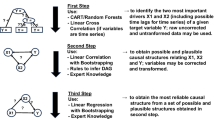Abstract
This paper is concerned with the problem of detecting causality in spatiotemporal data. In contrast to most previous work on causality, we adopt a logical rather than a probabilistic approach. By defining the logical form of the desired causal rules, the algorithm developed in this paper searches for instances of rules of that form that explain as fully as possible the observations found in a data set. Experiments with synthetic data, where the underlying causal rules are known, show that in many cases the algorithm is able to retrieve close approximations to the rules that generated the data. However, experiments with real data concerning the movement of fish in a large Australian river system reveal significant practical limitations, primarily as a consequence of the coarse granularity of such movement data. In response, instead of focusing on strict causation (where an environmental event initiates a movement event), further experiments focused on perpetuation (where environmental conditions are the drivers of ongoing processes of movement). After retasking to search for a different logical form of rules compatible with perpetuation, our algorithm was able to identify perpetuation rules that explain a significant proportion of the fish movements. For example, approximately one fifth of the detected long-range movements of fish over a period of six years were accounted for by 26 rules taking account of variations in water-level alone.
Access this chapter
Tax calculation will be finalised at checkout
Purchases are for personal use only
Similar content being viewed by others
Notes
- 1.
At line 3 of the algorithm we are required to iterate over the power set of \(\mathcal E\). Since this leads to combinatorial explosion if \(\mathcal E\) is too big, we in practice restrict the iteration to subsets of \(\mathcal E\) up to some predetermined size. In any case we are most likely to be interested in rules with a small number of causes in the antecedent.
References
Allen, E., Edwards, G., Bédard, Y.: Qualitative causal modeling in temporal GIS. In: Kuhn, W., Frank, A.U. (eds.) COSIT 1995. LNCS, vol. 988. Springer, Heidelberg (1995)
Allen, J.F.: Towards a general theory of action and time. Artif. Intell. 23, 123–154 (1984)
Bleisch, S., Duckham, M., Galton, A., Laube, P., Lyon, J.: Mining candidate causal relationships in movement patterns. Int. J. Geogr. Inf. Sci. 28(2), 363–382 (2013)
Bunge, M.: Causality. Dover, New York (1966)
Davidson, D.: Causal relations. J. Philos. 64, 691–703 (1967)
El-Geresy, B.A., Abdelmoty, A.I., Jones, C.B.: Spatio-temporal geographic information systems: a causal perspective. In: Manolopoulos, Y., Návrat, P. (eds.) ADBIS 2002. LNCS, vol. 2435, pp. 191–203. Springer, Heidelberg (2002)
Galton, A.: States, process and events, and the ontology of causal relations. In: Donnelly, M., Guizzardi, G. (eds.) Formal Ontology in Information Systems: Proceedings of the Seventh International Conference (FOIS 2012), pp. 279–292. IOS Press, Amsterdam (2012)
Lyon, J.P.: Snags underpin Murray River restoration plan. ECOS 177, 1 (2012)
Moens, M., Steedman, M.: Temporal ontology and temporal reference. Comput. Linguist. 14, 15–28 (1988)
Pearl, J.J.: Causality: Models, Reasoning, and Inference. Cambridge University Press, New York (2000)
Spirtes, P., Glymour, C., Scheines, R.: Causation Prediction and Search. Springer, New York (1993)
Terenziani, P.: Towards a causal ontology coping with the temporal constraints between causes and effects. Int. J. Hum Comput Stud. 43, 847–863 (1995)
Terenziani, P., Torasso, P.: Time, action-types, and causation: an integrated analysis. Comput. Intell. 11(3), 529–552 (1995)
Acknowledgments
Antony Galton’s work was supported by the EPSRC, project EP/M012921/1. Matt Duckham’s work is supported by funding from the Australian Research Council (ARC) under the Discovery Projects Scheme, project DP120100072. Alan Both’s work is supported by funding from ARC project DP120103758.
Author information
Authors and Affiliations
Corresponding author
Editor information
Editors and Affiliations
Rights and permissions
Copyright information
© 2015 Springer International Publishing Switzerland
About this paper
Cite this paper
Galton, A., Duckham, M., Both, A. (2015). Extracting Causal Rules from Spatio-Temporal Data. In: Fabrikant, S., Raubal, M., Bertolotto, M., Davies, C., Freundschuh, S., Bell, S. (eds) Spatial Information Theory. COSIT 2015. Lecture Notes in Computer Science(), vol 9368. Springer, Cham. https://doi.org/10.1007/978-3-319-23374-1_2
Download citation
DOI: https://doi.org/10.1007/978-3-319-23374-1_2
Published:
Publisher Name: Springer, Cham
Print ISBN: 978-3-319-23373-4
Online ISBN: 978-3-319-23374-1
eBook Packages: Computer ScienceComputer Science (R0)




